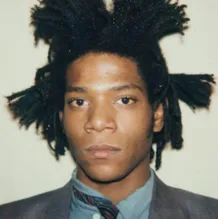
Jean-Michel Basquiat
Despite his brief life and career, Jean-Michel Basquiat made a significant impact on the art world.
Biography of Jean-Michel Basquiat
Jean-Michel Basquiat was born in 1960 in New York City. Facing difficulties at home during his teens, Basquiat left high school just a year before graduation, turning to art as a means of survival. He sold shirts and postcards showcasing his talents to sustain himself, often staying with friends in Brooklyn. In the late 1970s, his creativity found expression in graffiti, tagging street walls and trains under the moniker SAMO.
Despite facing challenges during his youth, art remained a constant presence in Basquiat's life. His mother, Matilda, nurtured his love for art by regularly taking him to Manhattan museums and making him a junior member of the Brooklyn Museum of Art.
During his financial struggle lasting over three years, Basquiat painted Lower Manhattan buildings with graffiti bearing messages like "SAMO as an escape clause" or "Plush safe he think.. SAMO" (SAMO meaning "Same old shit"). The artist even made an appearance on the TV show "TV Party." However, his breakthrough came with a group exhibition in the early 1980s. His work gained attention, leading him to join the Annina Nosei Gallery, where he worked towards his first solo show. It was a resounding success - Basquiat's pieces often combined words, phrases, cryptic symbols, and figures, deeply engaging viewers.
Basquiat's emergence in the 1980s art scene aligned with the rise of Neo-expressionism, known for its rough handling of materials, which suited him well. Despite transitioning to painting at one juncture, he retained his signature style of improvisation and "quick input." His collaboration with Andy Warhol bolstered Basquiat's fame as much as it did Warhol's work. Together, they created several "collaborative" paintings, each completing the other's work, garnering both positive and negative reviews over time.
Despite achieving worldwide critical acclaim in a remarkably short time, Basquiat faced a major challenge in his otherwise flourishing career — one that would hinder his creative output and affect his social behavior in his final years. The loss of his friend Andy Warhol took a toll on Basquiat, exacerbating his existing struggles with drug addiction and depression.
The fame he attained worked against him during the difficult period of the mid-1980s, leading to paranoia and isolation. In 1987, he sought sobriety during a trip to Hawaii, but unfortunately, it did not yield the desired results. Basquiat returned to New York in 1988 and tragically passed away from a heroin overdose in his gallery studio in the NoHo neighborhood at the age of 27.
Jean-Michel Basquiat's Art Style
By the age of 27, Basquiat had created over 1000 paintings and 2000 drawings, each imbued with purpose and deeper meaning. Whether addressing social issues or cleverly referencing various book content and knowledge, his works never lacked significance. With an African-Caribbean heritage, he frequently critiqued colonialism and racism in his paintings, drawings, and poetry. Influenced by Gray’s Anatomy, which he read as a child, he often depicted anatomical elements in his pieces. The foot, a recurring motif, appeared in many artworks, serving not only as a study of anatomy but also encompassing various historical and religious references within its narratives.
Basquiat's works were characterized by a pervasive duality, blending text and image, historical and contemporary elements. His narratives juxtaposed wealth and poverty, often interweaving mysterious, hidden meanings with primitive elements. This complexity contributed to the brilliance of his practice. While some aspects may appear crude, Basquiat employed them as tools to reveal deeper truths about the individual.
Years:
Born in 1960
Country:
United States of America, New York City
Gallery: